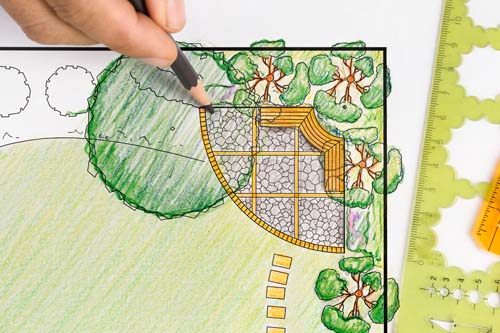Design
Our approach to landscape Design

Computer design is now a standard mode for landscape designers to render plans for prospective clients and the software has matured since it was first introduced but old-school designers like myself eschew its use for several reasons. I have seen plans that look good but do not completely connect with reality: More than a few times I have checked plans that specify installing plants (sometimes even large trees) in spaces where they would be short-lived or fail quickly. Sometimes plants are specified to be planted on top of manhole covers or utility boxes.
This may be a problem with the site analysis. Without a complete "hands-on" contact with the site and existing conditions, it is easy to fall back on a program that spaces plants mechanically and disregards the physical reality of the site and existing conditions.
To bring this issue ‘down to earth', I believe the first (and quite possibly the most important) step in the design process is to fully understand the soil quality and drainage. This can dictate what plants will thrive and which will fail. Too often contractors keep throwing the same wrong plants at a site that keeps killing them (either immediately or slowly and painfully). The notion of selecting the 'proper' plant is lost on many people, resulting in maintenance programs that could be avoided with a little extra investment of time and thought.
Another drawback of the automated design process is the over-use of generic plants which creates monotonous planting schemes and rules out variety and introduction of more exciting plants (including Natives). The current trend of grasses and leaf textures is exciting and expands the pallet beyond the usual treatment. Issues of Deer and other pests also require careful consideration. We have adhered to an organic approach for years. We generate our own compost (not bagged, but fresh and full of active microbes). The only sprays we generally use are Deer Repellent, Horticultural Oil and Hornet Spray.
While selection of recent introductions that may not be fully 'vetted', I feel it is always a good idea to try new things and be pleasantly surprised. Too many designers have a 'tried-and-true' approach that restricts more interesting gardens. The level of public awareness of the environment, access to online information and the need to encourage and support wildlife should push us ahead to embrace a new outlook on how we are part of Nature and get as involved as possible. Keeping this in mind, we like to encourage 'volunteers'- plants that spring up on their own (sometimes out of place) that may contribute something surprising.
In that regard, I always endeavor to involve my clients in the design process as early and as much as possible:
- Our first consideration is how the space can be best utilized.
- Next, we evaluate the site and soil conditions to get guidance to the proper plants and features.
- Then we set about correcting any soil/site issues, creating the best conditions.
- At this point we step back and assist any specialists as needed (we do not dabble in lighting or irrigation systems, leaving that to the experts).
- Now we are ready to install all the plants and add final touches.
- Once the installation is complete, we fine-tune the on-going maintenance program to insure plant health long-term vigor.
By involving our clients from the beginning, we ensure their satisfaction with the results and fulfillment of our joint vision. 'Involvement’ can extend to active participation in plant care; some people love to get down in the dirt and see the result of our efforts and get 'up close and personal' with their new green buddies.
If Life began in The Garden, perhaps we can all bring a bit of it back into our lives.
